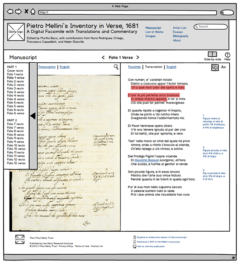
Artist Gala Porras-Kim at work in her studio
Artist Gala Porras-Kim, in her words, is a therapist for the museum. She excavates an institution’s repressed past: the long-forgotten storage rooms, the cracked potsherds and torn textiles, fragments that might otherwise be uncategorizable. In 2016, for example, she recreated the missing parts of shattered pottery shards, pieces of unknown provenance, found in UCLA’s Fowler Museum. “There’s always the miscellaneous category, or the random bits that are at the bottom of the box,” she said.
As the Artist in Residence at the Getty Research Institute, for the next two years Porras-Kim will join a cohort of scholars in developing work around the theme of the fragment. She hopes to conduct research in the special collections to understand how the fragments of objects are collected, catalogued, stored, displayed, and conserved, even as much about them is still unknown.

The Writing of Stones, 2015, Gala Porras-Kim. Sandstone, linen on panel, 48 3/4 × 37 1/2 in. Collection of Los Angeles County Museum of Art; purchased with funds provided by AHAN: Studio Forum, 2015 Art Here and Now purchase (M.2015.148). Photograph by Heather Rasmussen, courtesy Commonwealth and Council
Over the past decade, she has worked in collaboration with those who care for museum objects—registrars, archivists, conservators, and curators—in order to explore questions of cultural difference, loss, translation, and reconstruction. She sees her work as a proposal, a prompt for larger conversations about stewardship, institutional policy, property rights, colonial histories, and the nature of value. As part of an art piece for a recent fellowship at the Radcliffe Institute for Advanced Study at Harvard University, she met with the director of Harvard’s Peabody Museum of Archeology and Ethnography to discuss deaccessioning the sacred objects from the Cenote Segrado in Mexico—ritual offerings for the rain god Chaac smuggled to the United States by an American diplomat. “The project was to litigate on behalf of Chaac as if he was a person,” she said. “I wanted to think about the law as a sculpture, like I am defining the way that this material exists in the world and here’s how you should look at it.”
For another project, she’s thinking of proposing a public program with the animal rights group PETA to advocate for the lives of the moths that burrow into archival materials. “Moths also have a right to be fed and eat the things that we can’t care for. Why do we think that mold and moths don’t have rights?” she asks. “Conservators are trying to kill them. It would be a very interesting public conversation about what is more valuable to us—why do I think that the survival and maintenance of moths is not as important as maintaining historical objects properly?”
Challenging traditional ideas about preservation, Porras-Kim fears that the desire to acquire artifacts will outpace the ability to care for them. Rather than view artifacts through the lens of ownership, authenticity, and stasis, she asks viewers to see them as the changing products of conflict, exchange, and continual cultural entanglement. Their meaning, instead of being fixed, shifts as their contexts—from the altar, say, to the gallery—transform over time.
Her work explores the transnational condition: the objects that live in limbo, neither here nor there, enmeshed in complicated histories. She often returns to one of the chief questions in the field of cultural heritage: How to return looted museum objects to their original homes? For Porras-Kim, the question of repatriation is not so simple. “You can’t repatriate to a country when that country wasn’t there, or to a family when that family is not the actual people who owned it. It’s like not one or the other, but really a compromise.” In other words, how to return to a home that, far from singular or stable, is always moving?
“Art asks the questions,” Porras-Kim said, “but doesn’t give any answers.”




By this reasoning termites have a right to eat the timbers forming my house. They are not open to negotiation. They will not submit a written justification for eating my house. I have the power to destroy them in defense of my house. So I will exterminate them without going to court,.
That is life on this planet. I also might find a bird that enjoys eating termites and nature will save my cabin. Moths and termites have rights? Maybe a virus has the right to kill me. Sanity is needed. When moths elect a moth to Congress I may change my views ,
You have been thinking about and working with some of the same type of objects as am I: fragments of stone tools . These objects come from an excavation undertaken in the Former Republic of Yugoslavia, now North Macedonia.Thousands of these stone fragments, many used as tools, were sent to me to study in the 1970’s. I examined about 10,000 pieces, most microscopically to look for wear traces. The publication of the excavation included my chapter and this research was part of my dissertation. Years went by and since no plans had been made to return this material, it is ‘archived’ at the Cotsen Institute of Archaeology at UCLA. Occasionally students look at and examine the pieces that were used as tools or as cores. Before the pandemic two archaeologists wrote to me ( from Frankfurt and from Skopie) ; they were returning to the site to excavate further. I wrote them about this lithic collection and presumably we will be in touch once the pandemic ebbs. Your work fascinates me for you have moved with fragments into a world of art. Perhaps we can talk at some point. Much good luck!
For another project, she’s thinking of proposing a public program with the animal rights group PETA to advocate for the lives of the moths that burrow into archival materials. “Moths also have a right to be fed and eat the things that we can’t care for. Why do we think that mold and moths don’t have rights?” Do silverfish have some kind of right to munch on books? What’s next? Cockroaches, mosquitos, and fleas? Really, this is beyond silly.
I agree! Absolutely ridiculous!
I wonder why
God made the fly?